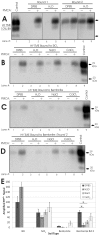Effects of solution chemistry and aging time on prion protein adsorption and replication of soil-bound prions
- PMID: 21526178
- PMCID: PMC3079715
- DOI: 10.1371/journal.pone.0018752
Effects of solution chemistry and aging time on prion protein adsorption and replication of soil-bound prions
Abstract
Prion interactions with soil may play an important role in the transmission of chronic wasting disease (CWD) and scrapie. Prions are known to bind to a wide range of soil surfaces, but the effects of adsorption solution chemistry and long-term soil binding on prion fate and transmission risk are unknown. We investigated HY TME prion protein (PrP(Sc)) adsorption to soil minerals in aqueous solutions of phosphate buffered saline (PBS), sodium chloride, calcium chloride, and deionized water using western blotting. The replication efficiency of bound prions following adsorption in these solutions was also evaluated by protein misfolding cyclic amplification (PMCA). Aging studies investigated PrP(Sc) desorption and replication efficiency up to one year following adsorption in PBS or DI water. Results indicate that adsorption solution chemistry can affect subsequent prion replication or desorption ability, especially after incubation periods of 30 d or longer. Observed effects were minor over the short-term (7 d or less). Results of long-term aging experiments demonstrate that unbound prions or prions bound to a diverse range of soil surfaces can readily replicate after one year. Our results suggest that while prion-soil interactions can vary with solution chemistry, prions bound to soil could remain a risk for transmitting prion diseases after months in the environment.
Conflict of interest statement
Figures





Similar articles
-
Replication efficiency of soil-bound prions varies with soil type.J Virol. 2011 Jun;85(11):5476-82. doi: 10.1128/JVI.00282-11. Epub 2011 Mar 23. J Virol. 2011. PMID: 21430062 Free PMC article.
-
Mitigation of prion infectivity and conversion capacity by a simulated natural process--repeated cycles of drying and wetting.PLoS Pathog. 2015 Feb 9;11(2):e1004638. doi: 10.1371/journal.ppat.1004638. eCollection 2015 Feb. PLoS Pathog. 2015. PMID: 25665187 Free PMC article.
-
Alteration of Prion Strain Emergence by Nonhost Factors.mSphere. 2019 Oct 9;4(5):e00630-19. doi: 10.1128/mSphere.00630-19. mSphere. 2019. PMID: 31597719 Free PMC article.
-
Soil-mediated prion transmission: is local soil-type a key determinant of prion disease incidence?Chemosphere. 2012 May;87(7):661-7. doi: 10.1016/j.chemosphere.2011.12.076. Epub 2012 Jan 21. Chemosphere. 2012. PMID: 22265680 Review.
-
Understanding Intra-Species and Inter-Species Prion Conversion and Zoonotic Potential Using Protein Misfolding Cyclic Amplification.Front Aging Neurosci. 2021 Aug 3;13:716452. doi: 10.3389/fnagi.2021.716452. eCollection 2021. Front Aging Neurosci. 2021. PMID: 34413769 Free PMC article. Review.
Cited by
-
Role of prion protein aggregation in neurotoxicity.Int J Mol Sci. 2012;13(7):8648-8669. doi: 10.3390/ijms13078648. Epub 2012 Jul 11. Int J Mol Sci. 2012. PMID: 22942726 Free PMC article. Review.
-
Attachment of pathogenic prion protein to model oxide surfaces.Environ Sci Technol. 2013 Jul 2;47(13):6925-34. doi: 10.1021/es3045899. Epub 2013 May 30. Environ Sci Technol. 2013. PMID: 23611152 Free PMC article.
-
Detection of chronic wasting disease prions in the farm soil of the Republic of Korea.mSphere. 2025 Feb 25;10(2):e0086624. doi: 10.1128/msphere.00866-24. Epub 2025 Jan 30. mSphere. 2025. PMID: 39882869 Free PMC article.
-
Detection of chronic wasting disease prion seeding activity in deer and elk feces by real-time quaking-induced conversion.J Gen Virol. 2017 Jul;98(7):1953-1962. doi: 10.1099/jgv.0.000844. Epub 2017 Jul 13. J Gen Virol. 2017. PMID: 28703697 Free PMC article.
-
Prion Partitioning and Persistence in Environmental Waters.Environ Sci Technol. 2025 Mar 25;59(11):5715-5725. doi: 10.1021/acs.est.4c11497. Epub 2025 Mar 13. Environ Sci Technol. 2025. PMID: 40080723 Free PMC article.
References
-
- Prusiner SB. An introduction to prion biology and diseases. In: Prusiner SB, editor. Prion Biology and Diseases. Cold Spring Harbor, NY: Cold Spring Harbor Laboratory Press; 2004. pp. 1–89.
-
- Castilla J, Saa P, Hetz C, Soto C. In vitro generation of infectious scrapie prions. Cell. 2005;121:195–206. - PubMed
-
- Taylor DM. Inactivation of transmissible degenerative encephalopathy agents: a review. The Veterinary Journal. 2000;159:10–17. - PubMed
Publication types
MeSH terms
Substances
Grants and funding
LinkOut - more resources
Full Text Sources
Other Literature Sources
Research Materials

